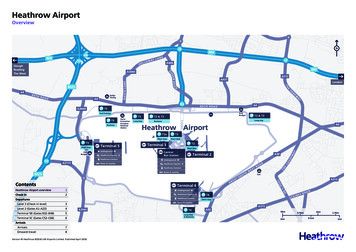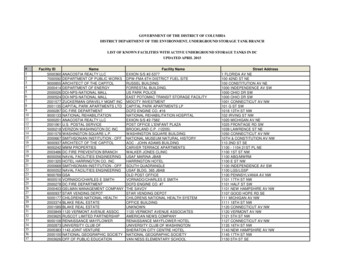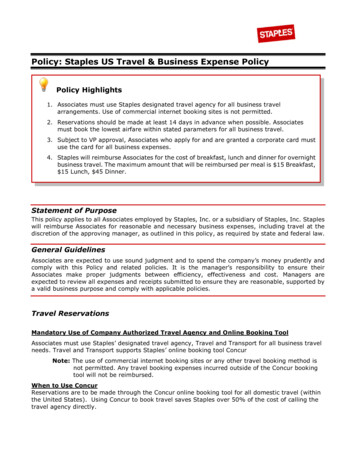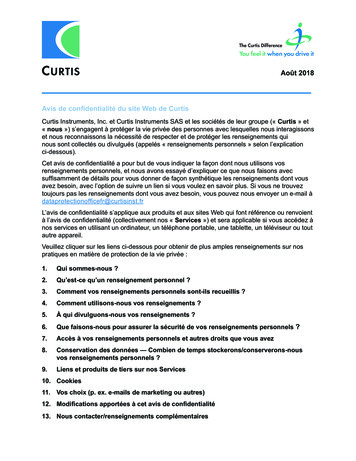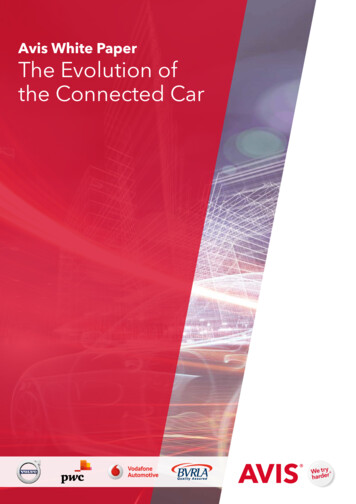
Transcription
Avis White PaperThe Evolution ofthe Connected Car
Executive SummaryImagine a world where you can start your car’s engine from twostreets away and your office building asks you if you want to keepthe lights on or off overnight, while your fridge reminds you thatyou have nothing left for dinner. What will it mean for you and yourbusiness?This might sound like something from science fiction, but actually this is already happening today.From cars to office buildings, objects are getting smarter, and connected car technology is set torevolutionise the car rental industry.For years, car rental hasn’t dramatically changed. While vehicles have upgraded and servicesimproved, customers still go to a counter, sign paperwork, collect keys and head to their vehicle. Butas the world embraces connected car technology, this will all change – and it’s happening now.We’ve seen ‘digital’ disrupt and reshape other markets, such as music, photography, retail and – morerecently – taxi hire. Industries such as banking have developed thanks to advances in technology, withmobile phones now a representing a valid alternative payment method, much faster and more efficientthan cash machines and debit cards. And, thanks to the connected car, we can now expect to see carrental transformed, too.Technology is evolving at a fast pace, and the connected car will soon become the new normal. Itspotential benefits are numerous, with telematics and the collection of data adding to the shift towardsmobility as a service, which could have a big effect on both car rental and the wider automotive industry.With the potential for autonomous cars on the rise, it’s becoming increasingly obvious that connectedcars are already here and they are prompting new questions, posing new challenges and providing newopportunities that automotive companies and others are trying to address. These include safety and liability,data usage and security, and the transition towards service provision, amongst others.The connected car has the potential to transform the car rental experience of the future, with opportunitiesto make people’s car journeys smoother, more efficient and more enjoyable – with the simple tap of an app,people will be able to see which car has been assigned to them and have the option to change it if necessary.They will be able to open the car without a key, and the paperwork would have already been taken care ofthanks to sign up process of the app.This vision for the future is just an example as connected technology is set to revolutionise not only theautomotive industry, but also business models of other related industries such as telecoms, insurance and leasing.It will also have an effect on mobility solutions and how travel and procurement managers provide these fortheir employees.In this report, Avis has brought together different perspectives from business leaders who share their take andinsights on the connected car revolution, and what it could mean for the car rental industry.2
THE EVOLUTION OF THE CONNECTED CARContentsIn chapter one Nina Bell of Avis Budget Group defines the connected car, talks about telematics andintroduces the concept of mobility as a service – which could have a big effect on both car rental andthe wider automotive industry.Chapter two sees Vodafone’s Dr. Nicolaus Gollwitzer shed some light on the benefits thatconnected cars will bring - and on the roles that telecoms firms, car makers and others could play inthe future. He explains that the data generated by millions of connected car journeys will becomean asset in its own right.In chapter three Anders Eugensson of Volvo focuses on the car maker’s efforts to createself-driving cars – with safety as its guiding principle throughout. He sets out the considerablebenefits of autonomous vehicles and insists that manufacturers should take liability fortheir vehicles.Chapter four covers Carlo Gagliardi of PricewaterhouseCoopers’ (PwC) analysis ofthe future challenges and opportunities posed by the connected car. These includeencroachment on the car industry by tech giants such as Google and Apple, the transitiontowards service provision and a suggestion of four key “ways to play” that firms could make.Chapter five sees Jay Parmar of the British Vehicle Rental and Leasing Association(BVRLA) focusing in on the specific concerns of rental firms and fleet operators – includingdata usage and security, telematics for fleets and the shift towards mobility as a service.Finally, in chapter six, Nina Bell wraps up by emphasising the revolutionary nature of theconnected car for the industry and describing the car rental experience of the future.She also details the steps Avis is already taking towards that future with pilot schemesin the UK.3
About the AuthorsNina Bell, Managing Director,Northern Region (EMEA), AvisBudget GroupNina Bell is responsible for theAnders Eugensson, Director ofGovernment Affairs and CoreValues Communications, VolvoCar CorporationCompany’s vehicle rental operationsAnders’s role is part of the cross-in Denmark, Norway, Sweden and thefunctional team responsible forUnited Kingdom. Nina has over 13defining the long-term Volvo Carsyears’ experience with Avis Budgetsafety strategies. Having joined VolvoGroup and spent three years as Strategyin 1984 Anders has been involved inDirector, EMEA, before her current rolethe structural crashworthiness designas Managing Director. Prior to this role,of the Volvo 850, before joining theshe led a new business developmentlegal requirements department andteam, implementing strategic initiativeslater the Volvo Safety Centre, workingacross the region.on strategic issues as well as interactingwith governments and policymakers.4
THE EVOLUTION OF THE CONNECTED CARCarlo Gagliardi, Strategy Partner,PwC StrategyDr. Nicolaus Gollwitzer, GlobalHead of Telematics, Internet ofThings (IoT) and Chief ExecutiveOfficer, Vodafone AutomotiveJay Parmar, Director of Policyand Membership, British VehicleRental & Leasing Association(BVRLA)strategy and differentiation, and hasNicolaus joined Vodafone in MarchSince joining the organisation in 2000,authored various articles on digital2011 as Global Head of Technical,Jay has successfully led the deliveryadvantage. He specialises in digitalInternet of Things (IoT). With overof the three key drivers of BVRLAtransformation and innovation,two decades’ experience in themembership: status and credibility;including “Connected Life” and newtechnology and telecommunicationsvoice of the industry; and informationbusiness models made possible by thesectors, Nicolaus successfully led theand guidance. Jay is adept at lobbyingemergence of Digital Identities. CarloGlobal Technical IoT team, enablingto promote the benefits of theleads the PwC Digital Practice in thethe completion of multiple businessindustry and consults regularly withPwC Strategy& UK. He has 25 yearstransformation programmes andpolicymakers to ensure fairer legislationof experience in advising clients andimprovement of the customer serviceis produced to support sustainableroutinely facilitates workshops withorganisation. Since the acquisition ofgrowth and safer roads. He utilises hisCXOs and presents at conferences onCobra (now Vodafone Automotive) inWhitehall and Westminster network tothemes around growth, advantage and2014, he has led Vodafone’s Globalsecure a good deal for the fleet sectorinnovation in the Digital Age.Telematics team to deliver world classand negotiates hard for his membersconnected car services and productsand their customers.Carlo is one of PwC’s global thoughtleaders and practitioners in digitalfor the automotive, fleet and insuranceindustries.5
CHAPTER ONEWhat is a connected car?Contributed by Avis Car RentalMost cars coming off the production lines now are “connected” – meaning that they offer internetconnectivity, along with a local Wi-Fi network, allowing devices inside or near the car to share thatinternet access, while Bluetooth allows people to use the system to make hands-free phone calls.Like other devices which are part of the “internet of things” – such as fridges, cookers and security systems– the vehicle is able to use its connectivity to offer new functionalities to the owner. Advances in technologyhave resulted in innovations from a whole host of industries – Samsung’s Family Hub Refrigerator takespictures of fridge contents to monitor what food is left and can tailor product recommendations based onpreferred foods; British Gas’s Hive system allows you to control home appliances from heating to sensorsfrom a mobile, tablet or laptop; Sonos can access speakers to play different music in different rooms at thesame time.A recent study carried out by Avis discovered that only57 per cent1 of respondents actually knew what was meantby the term. While driverless cars have been grabbing theheadlines there is still work to be done in educating thepublic about connected cars.Only 57% ofpeople knew of the term"Connected Car"TelematicsThe term “telematics” has mainly been associated withFleet operators can also benefit from theseinsurers monitoring drivers’ habits, often using “black boxes”features, and commercial vehicle operators areto keep tabs on drivers deemed to be a high risk.already forging ahead with applications specificBut connected cars offer so much more – from satellitenavigation with instant updates on live traffic information toallowing communication between cars and “smart” streetsigns and other connected vehicles.Data is the key to telematics. As vehicles become moreintelligent, they produce more information that can beanalysed and shared to improve the driving experience, tobolster existing services and to create new ones.Data brings benefits to the driver, the manufacturer, themobile provider and the vehicle owner: it can enhance safetyand sharpen engine performance, offer emergency warningand distress call systems, vehicle tracking, vehicle diagnostics,maintenance alerts and tools to improve fuel efficiency.6to the demands of freight haulage and passengertransport. For example, Stobart Group, whichoperates 2,500 trucks in the UK, logs details of everydelivery in real-time, enabling vehicle movementsto be rearranged at a moment’s notice to increaseefficiency and reduce empty trucks on the road2.But the use of data presents its own challenges andconcerns, particularly to consumers. Our recent studyfound that people are uncertain about how the datawill be used – and by whom. In fact, just 10%3 said theywould be happy for their data to be shared with a thirdparty while an additional 40%⁴ said they would wantto give express permission in order to do so. We willexplore this key element of the connected car furtherwithin this report.
THE EVOLUTION OF THE CONNECTED CARConnected vs autonomous“With connected car technology movingforward every day and the potential toaffect a huge range of industries, it’s crucialthat we share knowledge and explore theopportunities that it presents. As you willdiscover in this report, telematics, data andnew mobility services are among us, andtheir proper application and usage canprovide huge gains – both today and longinto the fully autonomous future.”Fully autonomous cars are the next step in the evolutionof transport, building on connected car services to makejourneys safer and more efficient. Autonomous cars are highlyconnected and will have the ability to talk to other nearbyvehicles and the road infrastructure, to optimise traffic androad safety and to manage parking tolls and other publicservices, leaving the driver to get on with other activities, forexample catching up with their emails. While some of theseelements already exist, the fully autonomous vehicle is still aconcept that has yet to be fully realised.While a number of trials are already underway by carNina Bell, Managing Director for the Northern EMEA Region,Avis Budget Groupmanufacturers to push the boundaries of autonomousvehicles, currently they remain semi-autonomous. This meansthey can handle some parts of the journey, but the driver mustremain alert and ready to take control where required.And that is the main difference between a connected carand an autonomous vehicle: connected cars offer benefitssuch as traffic and navigation information, parking assistanceand predictive emergency braking – all of which assist thedriver – but an autonomous vehicle can drive itself.1Avis survey, conducted in June 2016, 112 respondents2http://eddiestobart.com/about3Avis survey, conducted in June 2016, 112 respondents4Avis survey, conducted in June 2016, 112 respondents7
CHAPTER TWOConnected,automated, sharedContributed by Vodafone Automotive“The automotive industry is in the middleof a technological revolution – and whetheryou’re a car manufacturer, fleet operator,town planner or insurer, the radicalchanges are set to affect you. A new kindof transportation ecosystem is being builtfor tomorrow, and in it nearly everything wetake for granted about owning and usingvehicles is ready to be reinvented. Thosewho embrace these radical changes can turnthe disruption into an opportunity”.Dr. Nicolaus Gollwitzer, Global Head of Telematics,IoT and CEO Vodafone Automotive8
THE EVOLUTION OF THE CONNECTED CARThe connected vehicle: changing thetravel experience Better reliability will result from the issuing of over-theair (OTA) updates to vehicle systems, correcting faultsremotely, without the huge cost of a traditional recall.Millions of connected cars are already on the road and thenumbers are growing rapidly, it is predicted that one-in-five Connected cars can inform dealers and drivers aboutpassenger vehicles will be connected by 20195. Just as weproblems and book vehicles in for upcoming services. Incan no longer tolerate a home, hotel or office without Wi-Fi,some countries, the local authorities will also require newwe expect our vehicles to be part of our always-on lives.vehicles to come with connectivity to alert the emergencyservices in the event of an accident or breakdown.“Connected vehicles will deliver valuefor everyone.”37% of people wantmobile connectivity in cars6Dr. Nicolaus Gollwitzer, Global Head of Telematics,IoT and CEO Vodafone AutomotiveUltimately consumers, car manufacturers and related Connected fleet management solutions give controllers upto-date insight in order to optimise the utilisation of driversindustries and players will see a range of mutual benefits:and vehicles; monitor safety, security and compliance,control running costs, and deliver a more responsive service Cars will be connected to the factory, allowing data flowto their customers.on vehicle performance and real-world user behaviour.Manufacturers can use this data to improve their productsand services, for example to develop more fuel efficient Creation of smart cities. Put the journeys of millions ofpeople and millions of vehicles together and what you haveengines.is a large part of the smart city. The data from the connectedvehicle will be a large part of what makes the smart cityfunction. Millions of vehicles could share data with trafficsignals, with other cars, with emergency services and withsmart parking bays to help overall traffic flow around thecity, to the benefit of all.Continued 5Juniper Research, 2015 - http://news.sys-con.com/node/33395666Avis survey, conducted in June 2016, 112 respondents9
CHAPTER TWOConnected,automated, sharedContributed by Vodafone Automotive53% saidvehicle to vehiclecommunicationis the future10
THE EVOLUTION OF THE CONNECTED CARBarriers to overcomeConclusionDespite the benefits, there are barriers for businesses toFrom the foundation of revenue-generating connected carovercome:services, the way consumers and enterprises use vehicles is Culture: Monitoring driving behaviour is not welcomed byall drivers. Economics: The purchases of fleet management solutionscan be delayed by lengthy vehicle replacement cycles,and the business case for investment may be weakened ordeferred by periodic economic slowdowns. Integration: To get the full benefit of investment, fleetmanagement solutions need to be integrated into supplychain systems, ecommerce, HR systems, Enterprise resourceplanning (ERP) and business processes across the business.Like any major integration exercise, this can be disruptive.poised for a dramatic shift. Far from isolating drivers from theworld around them, connected — interconnected — cars willlink people seamlessly to their homes, phones, workplaces,stores and the infrastructure.Strands of this new journey-centric ecosystem already exist,and given the long development cycles associated with cars,urban infrastructure and social change, all players in this newworld need to start work on shaping it today.Connected car services are an important first step, but just ascritical is working to forge non-traditional partnerships thatbenefit all parties, from the driver to the automotive companyto the media, insurance and public sector bodies. Technology: Conventional in-car electronics architectureswere not designed with today’s connected services in mind.Car manufacturers will need to learn from the IT world andaccelerate their adoption of new car network architecturesbased on faster technologies like Ethernet, and moreresilient models, like clustering. Security and Privacy: Securing the connected and selfdriving vehicle is a hot topic for manufacturers, regulatorsand insurance companies. While automotive manufacturersand their component suppliers have a significant role toplay in securing the car as an endpoint, all participantsin the interconnected transportation ecosystem mustcontribute to securing the data as it flows. Also, dataprivacy, compliance and data sovereignty are issues thatmust be considered very seriously.“Interconnected transportation is acomplex and exciting journey for everyoneinvolved, across industries and acrossthe world. Partnerships are fundamentalto establishing the data flows andcommercial models that will underpin atruly customer-centric mobility ecosystem.”Dr. Nicolaus Gollwitzer, Global Head of Telematics,IoT and CEO Vodafone Automotive11
CHAPTER THREEThe future ofindividual mobilityContributed by Volvo Car CorporationConnected car technology has opened up a world of possibilityfor the automotive sector – and that technology is pointing to asingle guaranteed future: fully autonomous vehicles.“Self-driving cars will change the world. As afirm that has always prioritised the safety ofdrivers, passengers, pedestrians and other roadusers, we see autonomous driving as a naturalextension of our philosophy of car making.”Anders Eugensson, Director of Government Affairs and CoreValues Communications, VolvoThat philosophy has led to the Volvo Vision 2020:AIMING FOR ZERO:VOLVO VISION 2020’Our vision is that by 2020no one should be killed or seriouslyinjured in a new Volvo car’12
Image supplied by VolvoTHE EVOLUTION OF THE CONNECTED CARVolvo’s Anders Eugensson takes the longer-term view of whatcan be achieved with self-driving cars.Benefits of autonomous carsThe advantages of realising truly autonomous technology invehicles are huge:“For rental cars, instead of just using appsfor booking – the car will actually driveitself to you. There will be no need to go tothe rental place.” Autonomous cars allow you to spend the time in your carhow you want. Parking stress could also be ended with their occupantsable to hop out at their destination and leave the vehicle totake care of parking itself.And while current semi-autonomous cars insist that the driver Town planning can be improved as car parks will take upkeeps his or her hands on the wheel and attention engaged,less space with lower ceilings and more narrow parkingVolvo sees the technology as having the potential to free upspaces. They can be outside of town, as the car willtime for work or leisure. For example to read, see a movie,park itself.update Facebook, and check emails. “Older people see beingconnected as a distraction from driving, younger people seedriving as a distraction from being connected.” Autonomous driving cars will be legal, cautious and polite. They will offer greater mobility for the blind and forthe disabled. Traffic flow will be improved with no crashes or81% ofdrivers say safety istop prioritydisturbances, and vehicles will co-operate with one another.Speed will be set to optimise traffic flow. Commercial transport will be a major application forautonomous driving, with freight and public transportboth likely to be early adopters in some circumstances.Intermodal transport, moving people between transporthubs, is likely to be an early application for autonomouscars.Continued 13
CHAPTER THREEThe future ofindividual mobilityContributed by Volvo Car CorporationTechnical challengesWhile the technology holds a great many opportunities andexciting developments, there are of course many challengesto overcome: Testing every conceivable scenario Understanding unusual situations Cybersecurity – the car must be impregnable Privacy when connected Interaction between driver and vehicle Understanding liability, both civil and criminal and, who isliable for the crashes when the car is in control14Image supplied by Volvo
THE EVOLUTION OF THE CONNECTED CAROvercoming the challengesConclusionChallenges are opportunities that have yet to be realised andThe future of individual mobility is sooner than you may think,to ensure we overcome them; Volvo has embarked on anyou will order the car you need, when you need it and it willambitious program of testing and development. The Drive Medrive to you from a shared car pool. You’ll then drive whereprogram is endorsed by the Swedish Government and aimsyou need to go and the car will take care of itself from there.to pinpoint the societal benefits of autonomous driving.Next year (2017) will see the largest-ever trial of autonomouscars for Volvo as 100 IntelliSafe Autopilot-equipped XC90swill be used on the roads around Gothenburg in Sweden.This begs the question: will we need to own cars in thefuture?Not necessarily. The type of vehicle you order might varyaccording to your needs on the day – and you will onlyMore than 30 miles of typical commuter route will be covered,pay for the amount of time you use it for. Volvo predictswith a maximum speed of 50mph for the vehicles involved.that manufacturers will develop a lifelong relationship withThe experiment is not just about proving that autonomouscustomers through this model.vehicles can function on the current road network, but is alsoBy offering the freedom to decide what we need for thatintended to discover how human drivers interact with theseparticular day – and what we want to do behind the wheelcars in the real world.– we open up new dimensions of mobility. The freedom ofSimilar experiments are set to follow in China and in London.being in control. A car designed around our customers andtheir needs.“We are on a very exciting road to thefuture – and it’s started already. Todaywe say oh my god there’s no one drivingthat car. Tomorrow, we will say oh my godthere’s someone driving that car. As ourtechnology develops and trials complete,we will continue to drive the industryforward and establish autonomous drivingas a part of our daily lives. After all, the bestway to predict the future is to shape it.”Anders Eugensson, Director of Government Affairs and CoreValues Communications, Volvo15
CHAPTER FOURRacing ahead withautonomous cars anddigital innovationContributed by PricewaterhouseCoopers (PwC)“Over the next five years, the connectedcar could disrupt the entire automotiveecosystem. Connected cars are the leadingedge of disruptive technology that’schanging not only the automobile, but thenature of the automotive industry.”Carlo Gagliardi,Partner and Co-Lead of the Digital Practise, PwCThe automotive industry will undergo fundamental change assemi-autonomous driving emerges, followed by an eventualshift to full autonomous driving. Auto makers will take on anew identity as providers of mobility services. This will openthe door to lucrative new digital revenue streams, especiallyas they begin to explore opportunities in other digital areassuch as entertainment, commerce and monitoring a driver’shealth and fatigue level.We foresee annual sales of connected car technologiestripling to 122.6 billion by 2021. This is a slight slowdown inadoption speed compared to earlier estimates, attributableto the decision by European regulators to give OEMs anextension to 2018 to install automatic emergency callingsystems.16
THE EVOLUTION OF THE CONNECTED CARCore pillars of the connected carThere are three pillars supporting the connected car market:1. Cars are becoming digital service platforms and carmakers will become mobility service providers.2. Data will drive the services, with autonomous carsdemanding granular mapping and environmental data on“Data is not a product – it is the newcurrency. And it is far more powerful thanmoney. Money can only be used to buy asingle item, but data can be used to buymany.”Carlo Gagliardi, Strategy Partner, PwCareas like lane markings, road signs and traffic flow.3. Connected cars will usher in a new ecosystem businessA vehicle is one of the many “things” in the Internet ofmodel, the car rental market is ripe for innovation butThings (IoT). Many players will offer digital services throughsecurity and privacy concerns must be overcome.connected car technology, ranging from entertainment tomobility management and health monitoring. These serviceswill be a highly fragmented market where competitors fromnumerous industries converge. Just about anybody canplay, but winners will be those that shape service offeringsto the needs of mobile customers and provide the best userexperience.“Cars are becoming software.”Carlo Gagliardi, Strategy Partner, PwCContinued 17
CHAPTER FOURRacing ahead withautonomous cars anddigital innovationContributed by PricewaterhouseCoopers (PwC)Seven functional areasWe see the connected cardeveloping around seven functionalareas:1. S afety: the ability to warn thedriver of road problems, andautomatically sense and preventpotential collisions.We expect overall revenuefrom digital auto content to grow204%, to 122.6 BILLION,between 2016 and 2021 .The key catalyst of this is theEuropean Union’s mandate toimplement emergency callingtechnology (eCall) by 2018.82. E ntertainment: the ability to providemusic and video to passengers andthe driver.3. Well-being: optimisation of the driver’shealth and competence. Examplesinclude electronic alerts that detect ormitigate fatigue.4. Vehicle management: support forminimising operating cost and – forexample – keeping up to date with servicingand traffic data.5. M obility management: guidance on faster,safer, more economical, and more fuelefficient driving, based on data gathered forthe vehicle.6. Home integration: the ability to link the car toyour home, office and other buildings, enablingseamless connection no matter where you are.7. Autonomous driving: the ability to operate thevehicle without a human driver at the controls.We expect connected cartechnologies to generate 40.3 BILLION in end-customerspending in 2016. Safety andautonomous driving accountingfor about 61%718
THE EVOLUTION OF THE CONNECTED CARNew players“To thrive in this business, auto makersand suppliers must learn to competewith new players, including technologycompanies native to the digital realm.”ConclusionWe foresee four ‘ways to play’ or business models emerging,and some large players may pursue more than one at thesame time.1. Aggregator of data and audiences - Collecting anddistributing vast amounts of data from connected cars willhave value for third parties, such as insurance companies.Carlo Gagliardi, Strategy Partner, PwCScale is the key to success for this way to play. Technologycompanies have the global scale and open systemsTechnology companies and auto makers operate withneeded to win as aggregators. Car manufacturers have aprofoundly different principles and this colours theircritical advantage with the control of primary data fromperspectives on autonomous vehicles. Auto makers have athe car.product manufacturer’s point of view. They see autonomousdriving technology as an add-on to existing platforms. Tech2. Digital service provider - Many players will offer digitalservices through connected car technology, ranging fromplayers, by contrast, see the connected car as a greenfieldentertainment to mobility management. Winners will beopportunity, with autonomous driving as the starting point.those that shape service offerings to the needs of mobileAuto makers favour proprietary technology tightly linked tohardware, emphasising reliability and regulatory compliance.Their development cycles are long and their closed systemscustomers and provide the best user experience.3. Digital augmented product provider - Many carmanufacturers will capitalise on their automotivedon’t interact well with outside technology.expertise and customer insights to help optimise theTechnology firms are less concerned about legacy systems.performance and utility of vehicles. They’ll offer a rangeThey value speed-to-market, versatility, rapid productof digital services such as fleet management, predictivedevelopment, and frequent iteration. Many operate on openmaintenance, and automated driving to operators of largeplatforms with standard protocols that can be used by a widevehicle fleets. This way to play requires exclusive control ofrange of players. Their products show keen understanding ofvehicle sensor data, billing relationships with customers,consumer needs, but can fall short in reliability and durability.secure navigation data, and access to the artificialintelligence engines in autonomous vehicles.“The ultimate winners will combine automaker and technology perspectives.They will get t
In chapter one Nina Bell of Avis Budget Group defines the connected car, talks about telematics and introduces the concept of mobility as a service - which could have a big effect on both car rental and the wider automotive industry. Chapter two sees Vodafone's Dr. Nicolaus Gollwitzer shed some light on the benefits that connected cars will bring - and on the roles that telecoms firms, car .




